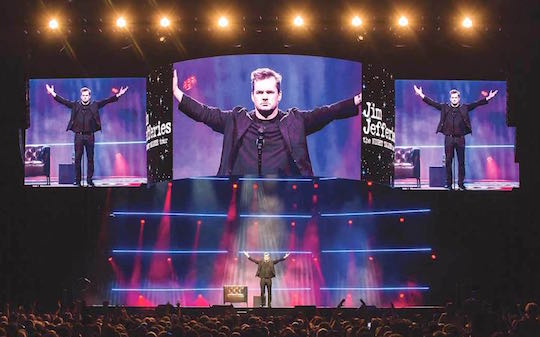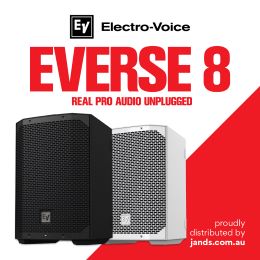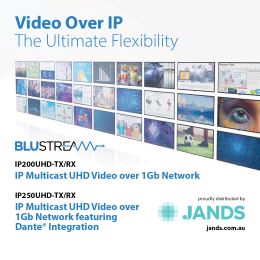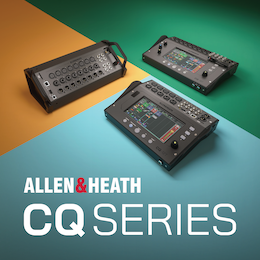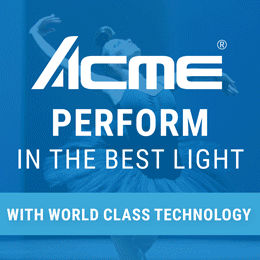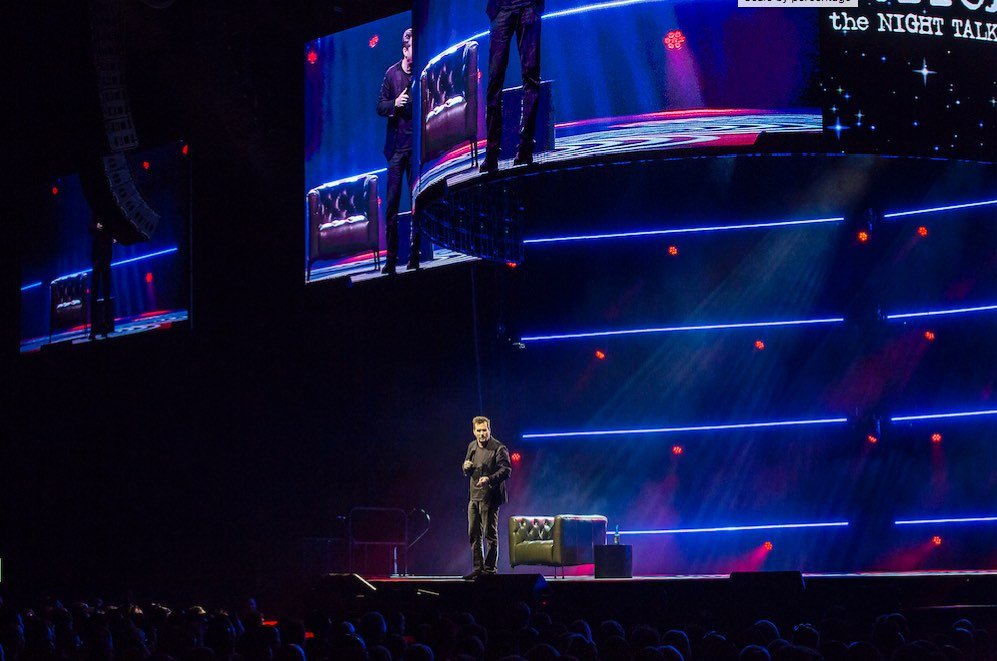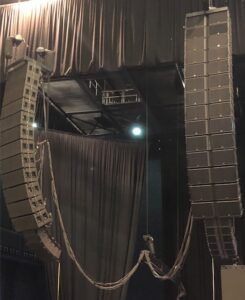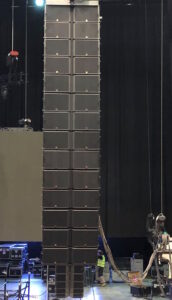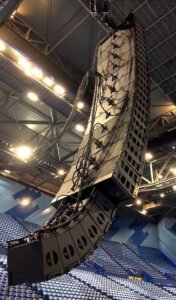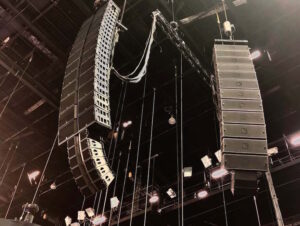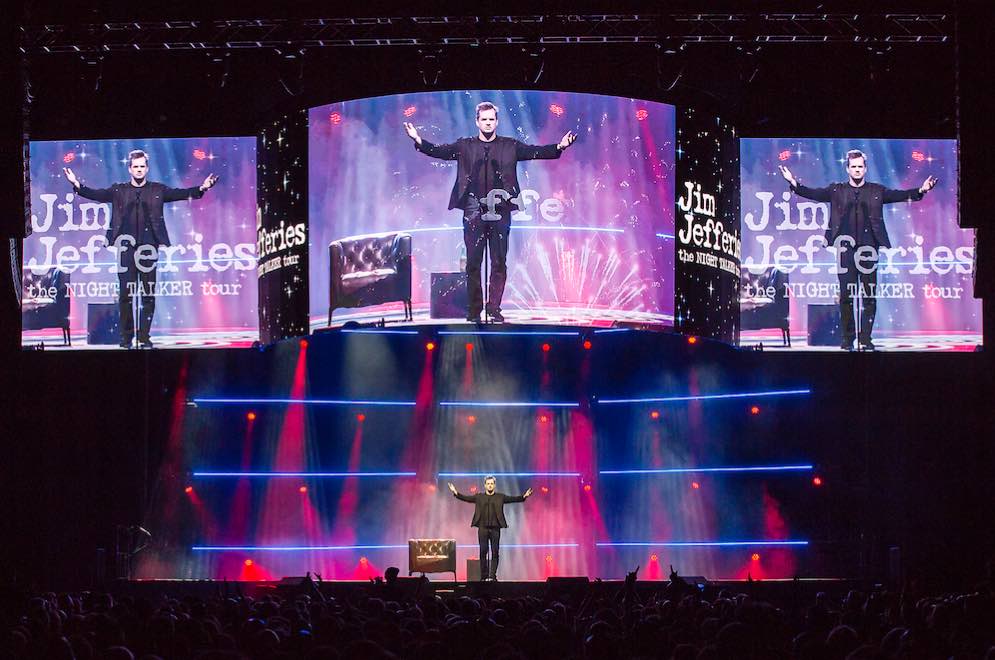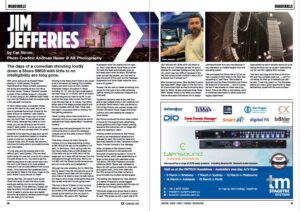Subscribe to CX E-News
ROADSKILLS
Jim Jefferies
by Cat Strom
Photo Credits: Andreas Heuer @AK Photography
The days of a comedian shouting loudly down a Shure SM58 with little to no intelligibility are long gone.
With comic acts such as Russell Peters playing to 17,000 people, the audio requirements for these comedic superstars are as big and exacting as any rock show. So when James ‘Oysters’ Kilpatrick posted a photo of the multiple hangs of L-Acoustic K1 he was using on Jim Jefferies Night Talker tour onto his Facebook feed, he copped quite a few sarcastic comments.
“A band makes noise, a comedian makes none so the input is very quiet, and so we have to generate the amount of level by the sheer amount of cabinets,” said Oysters.
“Basically if you don’t see a box in front of you, you don’t hear. It’s as simple as that. With a band, because they make so much noise, you can be off-axis to the PA and it doesn’t really matter. As soon as you walk away from a PA at a comedy show, it’s gone.”
Essential to the planning of gigs such as this are the room predictions based on whether a show is sold-out, curtained off or in an unusual mode, and JPJ Audio has become notorious for being able to accurately provide such information.
“It’s the prep and the drawing that is the difficult part,” said Oysters. “Plus we need quite a large PA crew but once it’s all in place, it’s quite simple to run. You have to get the opening sequence of cues correct and once the room is full there’s a lot more ambient noise and it can be quite different from sound check.
“Once everyone has quietened down and started to listen to the show, it gets to the point where it could almost run itself.”
Having said that, Jim doesn’t ever sound check and tends to start the show loudly, eventually settling into his normal talking voice. However, in the afternoon Oysters will take the artist’s microphone and walk every block of seats to ensure even and legible sound for all audience members even though this can take up to two hours.
Working to the theory that if there is any doubt at all of someone not hearing the comedian clearly, just point a box at them, Oysters employed a large L-Acoustics K1 setup including 14 x K1 with six Kara underneath in the main hang, 12 x V-DOSC with 6 dV-DOSC for side hang and six Kara for lip fill.
To not obstruct the large video screen the PA had to be trimmed high at 12 metres. Two ARCs either side of the stage provided side fill and the four wedges were all Clair. There were also eight L-Acoustics SB18 on the floor for the opening sequence.
“Most comedy shows have some form of cinematic intro so you need some low end to replicate that Dolby digital effect,” explained Oysters. Oysters says that people expect him to be running the show on some tiny analogue console and not the state of the art DiGiCo SD10 he uses.
“One thing I always do when mixing for comedy, is try to keep everything running at 96K AES all the way to the amplifiers,” he said.
“In the future, I think we’ll go with the new Shure radios that put AES straight out of the radio and put an AES card in at the stage rack so it stays AES all the way from the microphone through to the amp. We try run it at 96K with the Waves bundle because you get a lot more clarity and intelligibility.”
Although the crew shooting Jim for IMAG like that he doesn’t hold his microphone up to his face, Oysters has to deal with him holding it down below his chest or even his belly button. Jim likes to drink a beer whilst performing and that usually ends with his mic going lower.
“We took a Shure R Series on tour but took different heads to try,” said Oysters.
“We found that a DPA switched to hyper actually picked up the best from the mic down in that position. We used a dbx Feedback Suppressor when we opened his mic right up. Plus I used Waves Vocal Rider so when Jim talks the fader automatically goes up and fades back when he stops.
“Sometimes when you get big pauses, you may start to hear the sound of the room but the Feedback Suppressor and Vocal Rider make the room tone a lot quieter.”
Visually, the aim was to create something truly unique for this type of act whilst achieving optimal viewing for audiences irrespective of what seat.
“Audience members were at any one time able to see multiple shots of Jim creatively cut by director David Hendy,” said Joe Bonanno, CEO of Big Picture, who worked closely with Frontier Comedy’s Travis Hogan and Simon Johnson who were leading the charge on show design.
Big Picture produced the show video content in-house for the support acts, advertising, venue guidance and a high-impact opening sequence that welcomed Jim on stage with audio and lighting to match.
“Having content produced by Big Picture proved to be invaluable as variations and changes for each city could be made and approved instantly on site,” remarked Andrew Taylor, Frontier Comedy’s Tour Manager.
Video consisted of Big Picture’s newly landed ROE Carbon 5 LED panels with Brompton processing housed in T2 and T4 touring frames, which were assembled as a large curved screen with seamless wings. Two Barco HDX-W20 Projectors provided additional IMAG.
Signal was managed by Barco E2 with various presets for video rolls and support acts, Jim’s show state was five PiPs across all the video surfaces to accommodate the multiple camera angles.
The lighting was designed by Dave Jackson of Creative Productions whose biggest challenge was clearly placing light fixtures out of the way of the large video element.

Dave Jackson of Creative Productions
“Obviously single look shows have to have a big impact without much movement or cues,” he said. “We ended up with a back wall of 30 GLP X4S and 90 LEDBLADE LED strips to frame it all out.
“Overhead we had 16 Ayrton Mistrals for overhead lighting and key light for Jim, which was very difficult because of the way the curved screen worked! It was a bit of a mission but it worked out.”
After the second show, Dave decided to add a few Robe BMFL Beam wash on the floor for a bit of extra back light as they’re shooting fairly tight for IMAG.
He also employed three Robe BMFL Blades linked to his newly purchased Follow-Me system that allows him to assignunlimited fixtures from any manufacturer in any orientation to multiple targets from one operating system.
“We purchased the Follow-Me at LDI as we had a couple of other riders in the New Year requesting it,” said Dave. “We looked at Spotrack and the Robe RoboSpot but Follow-Me ticked all of the boxes … and of course, the fact it was already on riders was a big factor.
“Follow-Me offers a cost saving, quick to implement alternative to follow spots and rigging nightmares.”
Dave admits he didn’t actually have a lot to do during the show but he couldn’t resist taking out his new MA Lighting MA3 console.
“We were very busy at the time so all of our MA and Hog consoles were out ….. and I’m not letting my MA3 go to festivals just yet!” he said. “I had only used it on The Wombats before so it was a good opportunity to keep familiarising myself with the work surface.”
From CX Magazine – February 2019. CX Magazine is Australia and New Zealand’s only publication dedicated to entertainment technology news and issues – available in print and online. Read all editions for free or search our archive www.cxnetwork.com.au
© CX Media
Subscribe
Published monthly since 1991, our famous AV industry magazine is free for download or pay for print. Subscribers also receive CX News, our free weekly email with the latest industry news and jobs.


